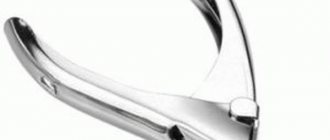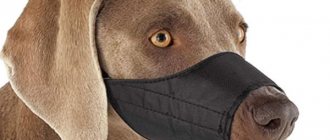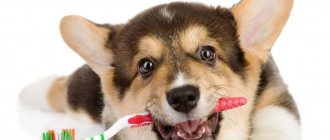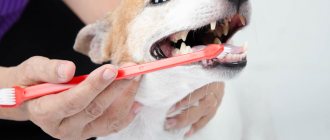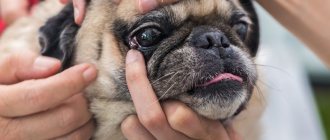Assembling and placing an IV in a dog - step-by-step instructions
- We treat our hands with antiseptic and put on gloves, which we also disinfect.
- Open the system and the bottle with the solution. Do not remove the entire metal cap from the bottle, only the central part.
- We insert 2 intake needles into the rubber cap and fix the bottle with the bottom up. When installing a drip at home, use the means at hand to hang the container - tape, electrical tape, a mop handle. The main thing is to securely fasten the bottle at a height of 45–50 cm above the animal.
Note! Using a disposable bag with handles, it is quite possible to build a “cradle” for a bottle of medicine. We cut a small hole in the bottom of the bag (so that the neck of the container can fit through), tie the handles tightly and use the resulting loops to hang the dropper on a trempel, hook or nail.
Errors and complications
Most complications are associated with mistakes made due to inexperience. Below you can see the most common ones.
The appearance of the ball
A small ball-shaped lump appears when the medication is administered too quickly and the course of treatment is prolonged. Smooth insertion and thorough massage at the end of the procedure will help to avoid its appearance.
Severe pain
The appearance of pain is possible due to improper dilution of the drug or increased sensitivity to the components included in the composition. Most often, a negative reaction occurs to antispasmodics and antibiotics.
Hitting the bone
If it gets into the bone, the drug will come out with great difficulty. There is no need to be afraid of this, since the selected needle is not capable of piercing such a dense formation. The maximum that can appear is a subcutaneous hematoma.
Appearance of blood
The appearance of blood on the surface of the skin or in the syringe occurs when blood vessels are damaged. Most often, this situation does not pose a danger and is easily eliminated on your own - the bleeding stops in a few seconds.
Nausea, weakness, fever
Such symptoms are acceptable after the introduction of a vaccine and medications that directly affect the causative agent of the disease. In both cases, they are an immune response, do not pose a danger to the animal and go away on their own within 2-3 days.
Materials
First of all, you will need all the materials needed to prepare the dropper:
- bottle : can be of different sizes. Adjust according to the amount of medicine to be given to the dog. You can also directly buy a larger bottle, which may come in handy in the future, especially if you have multiple pets in the house.
- infusion device : This is a clear plastic tube that connects a bottle to a needle, allowing the substance to pass through it. Has a wheel that allows you to adjust the fluid flow;
- hypodermolysis needle : This is the end part of the device that goes into the dog's skin. It is better to choose a medium to large needle to facilitate the flow of liquid.
© shutterstock
Preparing your pet for drug administration
Some animals hardly notice the injection, others behave restlessly or aggressively. In this case, it is worth calming the pet with conversation and stroking. In some cases, it is better to use a muzzle or a special restraint bag for miniature breeds.
Let your pet get used to the syringe. Fill it with a dose of medicine and give it a sniff. Be careful that the animal does not injure itself with the needle, keep the cap closed. You may not be able to smell the liquid, but trust me, your dog can!
Once you are sure that your pet is calm, it is time to give the injection.
If your dog has had injections before, he probably associates syringes with pain and discomfort. To combat this, give treats and use other forms of positive reinforcement such as praise and games.
Preparing the animal
When the dropper is ready for use, you need to calm the dog and prepare it for the procedure.
Removing hair at the injection site
The next step is to remove the hair between the elbow and wrist. It is shaved with a machine or cut with scissors.
Bandaging the leg with a tourniquet
The limb is tightened before the puncture. The tourniquet is applied slightly above the place where the infusion will be performed.
Inserting a needle into a vein and fixing it with an adhesive plaster
The needle is disconnected from the IV and carefully inserted into the vein parallel to the limb.
Useful tips
Be prepared for the fact that not everything will go smoothly the first time, especially since you are performing the procedure not on an adult, from whom you can learn about pain and well-being, but on an animal.
Whenever possible, contact your veterinarian for fluid therapy . Do it at home only if absolutely necessary.
Remember that all stages of this procedure must be carried out using sterile gloves and sterile instruments. Otherwise, you can introduce an infection into the blood.
Be sure to talk to the animal during the procedure; a confident and calm tone will help him in this unpleasant situation. The dog experiences stress from manipulations, even if they are painless.
Dropper assembly
The procedure for assembling the system is as follows:
- Wear gloves and treat your hands with antiseptic.
- Prepare a bottle of medicine and hang it on a tripod.
- Check your doctor's prescription: often the dropper is a saline solution to which other components are added.
- If necessary, open the ampoules with medications, draw the contents with a syringe and inject them into the sodium chloride solution.
- Print out the system for installing the dropper.
- Find the plastic tube and the regulator on it - it needs to be moved to the closed position. This is not difficult to do - the tube will seem to be pinched.
- Insert the needle into the cap of the bottle or a special hole in the bag with the injected solution.
- Remove the extra needle from the package and insert it next to the main one to prevent a vacuum from forming.
- Find a cylinder-shaped extension on the plastic tube. Press it several times - it is necessary that it is filled with the medicine to about half. Using this cylinder you will determine the rate of introduction of the solution.
Intravenous fluid administration to a dog
- To begin intravenous fluid therapy, your veterinarian will lightly sedate your dog and shave the area around the vein targeted for injection. This will allow the veterinarian to easily find the vein, insert the catheter and secure it with medical tape before connecting the IV.
- The IV is then connected to a bag of fluid (usually saline) that is lifted above the dog so that it can flow evenly by gravity into the body.
Subcutaneous administration to a dog
- The procedure for subcutaneous fluid administration is similar to intravenous fluid administration, but instead of inserting a catheter into a vein, a needle is used to transport the fluid under the dog's skin near the spine. The procedure is performed by veterinarians in a hospital setting, but is also commonly recommended for home use for dogs with chronic health problems such as kidney disease.
System structure
The drip device consists of several parts. Before you start using it, you need to know what all these parts are for.
Main part
This is a flexible tube. Along it, the drug gradually moves from the container to the needle and then enters the body.
Fence needles
There are only two of them in the set. Inserted into the lid of the container with the drug. One of them is connected to the tube, the second is equipped with an expander and provides air flow into the container with the infusion solution.
Dispenser
This is a box made of plastic, equipped with a slider or wheel. The dispenser is designed to regulate the speed of liquid movement.
Container chamber
The device is made of transparent soft plastic. A filter is placed inside the part to prevent air from entering the tube and blood.
Cannula
The main purpose of this part of the structure is to introduce additional drugs into the solution.
The part is a container made of plastic or a rubber pad.
Types of infusion needles
When placing an IV, different games are used. They have a number of features. If you lack the skills, not all types can be used at home. This issue needs to be examined in detail.
Infusion disposable
Attached to the system.
They differ in thickness and length. For subcutaneous injection into the withers, a medium-thick long needle is used. For intravenous infusion, which is considered more traumatic, a needle of medium length and minimal thickness is used.
Butterfly needle
A short, fairly thin needle. In people it is injected into small veins. Suitable for small pets. It has a special design: “wings” made of plastic are placed in front of the expander. With their help, the needle is conveniently fixed.
Intravenous catheter
This is a plastic tube designed to be inserted into a vein. The drug enters through the catheter, and then the gateway is closed with a stopper.
It is worth knowing how many days such a needle can be used: it can remain in the vein for up to six days, but only with proper care of the puncture site.
Can all needles be used independently?
Not all needles are allowed to be installed on your own by a puppy or an adult dog.
The catheter must be inserted exclusively by a veterinarian . In the absence of experience, there is a risk of damage to nerve endings and veins.
Rules for all procedures
It is important that the animal is calm during the procedure. To immobilize animals, you can use special retaining bags, which also serve as carriers. Thanks to the holes in the body, you can access any paw or back.
If the animal is large, additional safety precautions must be taken to avoid injury. For the purpose of prevention, dogs are muzzled and cats are swaddled.
A restraint bag will help immobilize the animal
Before carrying out any procedure, the hands of the person performing the manipulations, the skin of the animal, and the instrument must be disinfected.
Video - Rules for treating hands before performing manipulations
When placing intravenous drips in animals, the following rules are strictly followed:
- Solutions are warmed to room temperature or slightly warmer before administration. Refrigerated medicine can cause chills in the animal and lead to a drop in body temperature.
- The medicine is administered at a rate of 1 drop per 1–2 seconds (unless otherwise indicated in the instructions for the drug). Acceleration can provoke a worsening of the condition - tremors, increased blood pressure, vomiting.
- When administering the drug, care must be taken to ensure that no air gets into the vessel.
Attention! If the body temperature of a cat is below 38–39.5 °C, and that of a dog is 38.5–39 °C, then the tube through which the saline solution passes can be lowered into a container of water heated to 60–70 °C. But you should make sure that heating the drug is not prohibited by the manufacturer.
Subcutaneous infusion
Droppers with saline solution and some other drugs are administered subcutaneously to dogs and cats. This is also called subcutaneous infusion. The safest area for this is the withers.
The drug is administered in the following order:
- The cat or dog is fixed so as to gain access to the withers or inguinal fold.
- Bring the dropper into working condition and connect it to the bottle with the medicine.
- Using your hand, form a triangular fold on the skin in the selected area.
- Insert a dropper needle into the base of the formed fold.
- Connect the IV.
- Open the system.
- After administering the required amount of the drug, the system is shut off.
- Carefully remove the needle.
- Apply pressure to the injection site to prevent the medicine from leaking out.
Video - Subcutaneous drip
The speed of dripping subcutaneously can be maximum, since in this case the solution is absorbed very slowly.
Attention! An amount of the drug not exceeding 20 ml per 1 kg of animal body weight per day is administered subcutaneously. However, with severe dehydration, the dose may be higher - 40–50 ml/kg.
In the place where the drug enters, a subcutaneous bubble is formed. This is normal, since the fluid enters the subcutaneous tissue. It will disappear very quickly.
Thus, the following solutions are administered:
- glucose (5%) (if there are no contraindications in the form of chronic diseases, in particular diabetes, behavioral disorders, seizures);
- Ringer's solution, Ringer-Locke solution;
- saline solution (dripped heated to a temperature of 40–45 ° C).
The disadvantage of this method is that other drugs cannot be administered this way. In addition, the drugs act more slowly in this case.
When administering the drug subcutaneously, beginners make mistakes that prevent the drug from entering the body. In the first case, the needle is inserted intradermally, in the second, a through puncture is made, and the solution is poured into the external environment.
Grasping the skin at the withers for needle insertion
What you need to know when placing an IV
When carrying out the procedure, many points must be taken into account, otherwise irreparable harm will be caused to the animal.
Solution temperature
The drug should not be hot or cold. The best option is a drug at room temperature.
What to do if your dog's temperature is low
If your pet’s temperature is below normal, part of the plastic pipe intended for transporting the solution should be placed in a container with water heated to +70...+80 °C. Due to this, the drug passing through the system will warm up slightly. This helps normalize the animal's body temperature.
Solution infusion rate
The speed at which the solution is administered deserves special attention. It is unacceptable for the drug to enter the body too quickly. No more than two drops should be poured per second.
As the speed increases, the dog’s condition can deteriorate sharply, resulting in:
- gagging;
- increased blood pressure;
- shiver.
Constant monitoring of the pet during the procedure
During the procedure, the pet must be under constant supervision. The owner’s main task is to prevent the dog from running away and to promptly identify negative changes.
How to give an injection in the withers of a small, emaciated dog or puppy
Recommendations for small, malnourished dogs or puppies are practically no different. The only nuance is the size of the syringe and the depth of needle insertion. The safest and most painless option is insulin. It has the thinnest and shortest needle. Due to the short length, in most cases it is inserted to the end, but for the listed animals the depth can be reduced to half.
At the time of injection, be sure to keep the coat dry. If it gets wet, the selected depth is not sufficient to pierce the skin. In this case, you need to enter it a little further.
Injection rules for dogs
You need to calm down yourself. Yes, it is psychologically difficult to stick a needle into a pet; it is scary to hurt him or harm his health. You need to firmly understand that, firstly, an injection is a necessity for the pet’s health, and secondly, animals are much less sensitive to pain.
- It is most convenient to give injections to a dog together. A collar is put on the dog, which is held by an assistant with one hand. The assistant's second hand holds a very attractive food - it is brought to the dog's nose before the needle is inserted. The dog begins to eat and at this moment an injection is given. There should be enough food for the entire duration of the medication administration;
- If the injection is given subcutaneously (in the withers) or intramuscularly (in the hind leg), then the injection site should be rubbed with your hand to better distribute the medicine through the tissues and relieve the feeling of discomfort. Rubbing with your hand does not involve pressure or pressing on the injection site.
- Before the injection, the syringe should be warmed in your hand;
- For watery and glycerin preparations, any syringes can be used;
- Oily drugs are drawn into a syringe without a needle, the needle is put on after taking the dose of the drug;
- For puppies and small breed dogs, it is better to choose insulin syringes.
A number of important features when injecting a dog:
- Only a doctor can prescribe injections for a dog. Under no circumstances should you treat an animal based solely on your experience or desire. And the most serious thing is to exclude self-medication through injections;
- Before using the drug, the owner must fully read and understand the doctor's prescription. In some rare cases, it is possible to administer injections to dogs at home, but the owner should first consult with a veterinarian about the rules for administering injections. Very often, doctors prescribe medications in milligrams or grams; in these cases, it should be taken into account that we are talking about dry matter. This means that the solution must be converted into milliliters of a percentage solution. To avoid errors in calculations and negative consequences, it would be better to consult your veterinarian again about the specific number of milliliters per injection;
- Regular medical disposable syringes are suitable for all breeds of dogs;
- Shorter and thinner needles, similar to insulin ones, are suitable for injection.
How to properly handle syringes for dogs
- Disinfection of injection sites is not necessary, since the skin contains a dense acidic fatty layer in which most microorganisms cannot survive. Only dogs with weakened immune systems do not qualify for this item;
- The animal should be restrained to avoid aggressive or inappropriate behavior. Dogs react heavily to the pain associated with injections, so a muzzle and holding the dog (preferably by another person) is more than advisable;
- Direct administration of the drug should be carried out only when the needle enters through the skin. You can find out whether the needle has already been inserted using a simple algorithm. It feels like the needle will enter with difficulty at first, but then with increased pressure it will go further under the skin.
Beginners in this business are faced with the fact that thick dog skin is quite difficult to pierce. Based on this, emphasis should be placed on the very first movement of the needle. It should be sharp and strong, but with slight delays when inserting the needle every two to three centimeters. This point should be excluded during intravenous injection, since with it the needle should be inserted evenly.
A common problem with intramuscular injection is the appearance of a skin plug as it passes through the skin. When faced with this, the owner must stop pressing on the syringe, and the needle must be replaced with a new one.
On average, one ampoule of the drug is designed for one use. Opened ampoules almost instantly become unsterile, and after even an hour they are completely unsuitable for injection. Also, most solutions are not recommended to interact with oxygen, so the remaining solution in ampoules should be thrown away. Each ampoule of the drug is designed for single use.
Sometimes it is possible to mix different types of medications if they are compatible, but most often each injection requires separate needles, syringes, and even different areas of skin on the dog's body. Another important factor when performing injections is that there should be no air bubbles in the syringe. If the entry of a small bubble during subcutaneous or intramuscular injections is not too dangerous, then in cases of intravenous injections this is unacceptable, since even a small bubble can clog blood vessels.
And then the appearance of negative consequences, the sudden death of the dog. To get rid of air bubbles in the syringe, you need to point it up, tap lightly and then release a little of the solution. After injections under the skin or into a muscle, it is advisable to massage the injection area. This promotes even distribution of the medicine.
Having completed the introduction procedure, the area must be clamped with alcohol-based cotton wool or a cotton swab, remove the tourniquet from the dog and only then remove the needle, still holding the cotton wool. It is normal for a small amount of blood to leak in or out from the puncture. Frequent injections into the same area can cause pain in the animal, while pressing the puncture area with a tampon eliminates this phenomenon.
How to mentally prepare an animal for the procedure
- It is not advisable for the dog to see how the owner handles the syringe, so it must be prepared in advance;
- Most medications are recommended to be administered before a meal or a walk; the optimal time is considered to be the period after a meal or a walk, since at such times the dog especially wants peace;
- The use of brute force or intimidation is strictly prohibited. The dog should feel that nothing bad will happen to it either during the procedure or after it;
- The pet should be as relaxed as possible before the injection, since in tense areas the process of administering the solution becomes much more complicated.
If long-term drips or injections are necessary, it is better to resort to a venous catheter. It is installed on the animal for the entire period of treatment, but is possible only in specialized clinics and hospitals.
Chronic renal failure
As chronic kidney disease develops, the kidneys lose their ability to concentrate urine, causing increased fluid loss.
Increased thirst over time ceases to compensate for these losses.
Fluid loss leads to a decrease in total blood pressure and kidney pressure, which leads to a decrease in glomerular filtration rate. Urea and creatinine in the blood increase, which means the accumulation of toxins in the blood, this leads to a deterioration in the general condition, which becomes noticeable to the owners and they bring the animal for an appointment.
The doctor's task:
1 At the appointment, determine the degree of dehydration.
The animal may be fat and then you should look at the folds on the head and paws.
The animal may be emaciated and the degree of dehydration will appear higher because the skin is not initially elastic.
2 Determine the level of electrolytes in order to select a solution for droppers.
Cats lose potassium more than dogs.
If the potassium level is normal, then you can use saline solution.
If the Potassium level is low, then any solution containing Potassium.
If in the next tests (after 3 days) the Potassium level is still reduced, then Potassium tablets should be prescribed - Panangin, Asparkam.
Elevated Sodium - above the upper limit of normal, indicates a high degree of dehydration; half of the injected solution can be replaced with 5% glucose, with control after 3 days.
About collecting and installing an IV for a dog
So, first you need to treat your hands with an antiseptic and put on sterile gloves. Next, you need to open the system and the bottle of medicine. There is no need to remove the entire metal cover from it - just its central part. Then you need to insert two intake needles into the rubber cap of the container with the medicine and fix the bottle upside down. At home, to hang a bottle of medicine, you will have to use improvised means - a mop, electrical tape, tape. The container must be secured at a height of 40-50 centimeters above the four-legged patient.
Next, move the dispenser lever all the way, make 2-3 smooth presses on the reservoir with the filter. He will draw the medicine into himself under pressure. Shake the chamber slightly to release excess oxygen. Lower the dispenser lever and watch the medicine go down. It is important that there are no air bubbles in the tube below the filter reservoir.
The dog must be prepared for the procedure as follows. The optimal place for infusion is the wide veins of the forelimbs, so you need to first shave or trim the hair between the pet’s wrist and elbow. Next, you need to pull the paw with a tourniquet above the puncture area. In dogs, the veins are clearly visible. We insert a needle into the vein, disconnecting it from the dropper, parallel to the paw. This must be done carefully and slowly. The pressure should be moderate. Next, the needle is fixed on the paw with an adhesive plaster, and the tourniquet is removed. Only then does the system join. So, now the process of infusion of medicine has begun, and the owner’s task is to monitor the dog.
It is important that the solution for administration is warm. It often happens that a properly inserted needle comes out of the vein because the dog tenses the muscle. To prevent this from happening, you must constantly monitor the progress of the procedure.
After placing a drip, dogs may, in rare cases, experience allergic attacks. They are manifested by difficulty breathing, coughing, swelling of the lips and throat. If the above signs appear during the procedure, then it is necessary to stop it by removing the needle. In this case, the dog’s paw is pricked with a 0.1% solution of adrenaline. The same medicine must be administered intramuscularly. It is better to call a veterinarian if the animal’s condition does not improve after an injection of adrenaline.
Unforeseen circumstances and their consequences
Even with strict adherence to all rules, there is a risk of unforeseen situations. It is worth considering the most common ones in order to take the necessary measures in time.
The drug was administered incorrectly
A lump forms at the puncture site, the dog becomes restless and experiences pain in the affected area. Such problems often arise even with correct insertion: the animal periodically relaxes and tenses the veins, and the needle can come out.
For such problems, the lump can be injected with novocaine, but it is better to show your pet to a veterinarian to avoid negative consequences.
Allergy upon administration of the drug
The animal may develop an allergy to the administered drug. In this case, difficulty breathing occurs, lips and throat become swollen.
If such changes are observed during the procedure, you need to perform the following actions:
Close the dispenser.- Tighten the limb with a tourniquet. The main thing is not to clamp the paw for more than a quarter of an hour, monitor the pulse and temperature of the limb.
- Inject the leg with a solution of adrenaline (0.1%) or administer it intramuscularly. The dosage is calculated taking into account the weight of the animal.
Refusal to eat and drink after IV drip
With such changes, you need to constantly monitor your pet's condition. It is recommended to measure the animal’s body temperature, monitor its breathing rate and heart rate.
If all indicators are normal and the condition is improving, then you should wait a little. After this, the animal is given a warm drink.
If the condition worsens, you should contact a veterinary clinic.
Why you can't avoid injections
Even native breeds and disease-resistant artificially bred dogs. Laikas, Malamutes, Akitas, Schnauzers - if kept improperly or inbreeding, they produce very sickly offspring.
The healthiest dog can get sick - due to poisoning, a tick bite, injury, or severe childbirth. Therefore, knowing how to treat your dogs is important. It is difficult to force a dog to take a pill; they often vomit due to a hard, small object with an unpleasant taste getting into their mouth. Suspensions and syrups are often not suitable for dogs due to the risk of developing allergies. The active ingredient is included in the drug along with flavors, dyes, taste improvers, which are strong allergens. Not all medications prescribed to dogs are available in oral form.
Know how to give injections to a dog:
- This is assistance to the animal until the veterinarian arrives or until the dog is taken to the veterinary clinic. In emergency cases - poisoning, arrest of labor, heart attack, suffocation - this allows you to save the life of the animal;
- This will save money, since injection services are expensive, it is better to buy syringes, medications and inject the dog yourself. In addition, sometimes dogs have to be transported to the clinic by taxi, which is also expensive;
- This will allow you not to change your plans. If the pet is prescribed a course of treatment, then the owner’s ability to perform injections will not interfere with going to the country or on vacation with the dog, if, of course, it feels well and can do without constant monitoring of its health by a veterinarian;
- This has a beneficial effect on the animal, which may be tired of trips to the veterinary clinic, and the manipulations of a stranger cause stress.
- In general, the ability to inject your dog yourself is a very useful and necessary skill that any dog owner should master.
How to give an injection to a dog at the withers
Injections into the withers are called subcutaneous. A very large number of drugs prescribed to animals are administered subcutaneously due to low pain for dogs and ease of administration. Therefore, the owner needs to know how to give an injection in the withers of a dog, cat and other pets. Here's how to properly inject a dog at the withers:
- Fill the syringe with medicine;
- By pressing the plunger, remove air from the syringe until a drop of medicine appears from the needle hole;
- With one hand, pull the skin into a “house” at the withers in the area of the shoulder blades - the protruding bones where the neck ends and the back begins;
- If the dog has thick hair, it needs to be blown to the sides or straightened with your hand;
- Insert the needle into the recess of the “house” parallel to the spine and without piercing the fold of skin all the way through, using slow, constant pressure (a sharp insertion will cause it to bend on the thick dog skin). Press the plunger and inject the product into the skin at the speed recommended by the veterinarian.
We give injections into the muscle
Intramuscular injections are also common in veterinary practice, so the owner of the animal should know how to inject a dog intramuscularly:
- Draw up the medicine and remove air from the syringe;
- Mark the thickest area between the knee and hip joint;
- Insert the needle with a sharp movement - immediately to the desired depth (1/2 - 1 cm for small and medium-sized dogs, 1.5 - 2.5 cm for large and giant breeds).
- Inject the medicine at the required speed, but usually intramuscular injections are given slowly.
How injections into a vein are made
Owners are not taught how to give intravenous injections to dogs. This is technically difficult to perform, so if your pet is indicated for a course of injections into a vein, you should contact your veterinarian every time. If this is not possible, for example, the dog has a hard time traveling, or it is very large and cannot move, as a result, it is difficult to transport, then it is permissible to give intravenous injections yourself.
It will be interesting about the dog’s pedigree
You should ask the veterinarian to install a catheter on the dog’s paw, calculate the dosage of drugs for each injection and show how to properly administer the medicine in this case. The catheter will allow you to inject the medicine precisely into the vein and regulate the speed of administration (some drugs are injected slowly, others need to be injected quickly). In addition, the drug enters directly into the bloodstream, which means it begins to act a few seconds after the injection.
The mechanism of intravenous injection is as follows:
- The syringe is filled with medicine in a suitable quantity;
- By pressing the syringe plunger, air bubbles are removed;
- The bandage covering the hole with a valve is removed from the catheter;
- The syringe needle is inserted into the opening of the catheter;
- By pressing the piston, the medication is injected while maintaining the rate of administration;
- The catheter opening is closed with a valve or a fresh bandage.
After an intravenous injection, the dog may take care of its paw for some time, limp on it, or not use it when walking. This is considered normal if it goes away within an hour or two after the injection. If you have been protecting the paw for a longer period of time, the limb is swollen, or a vein is pulsating on it, then you should immediately contact your veterinarian.
